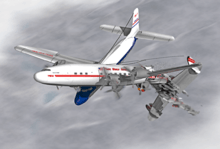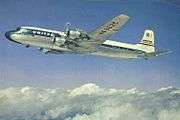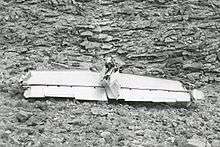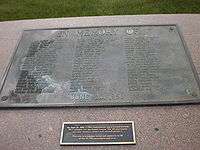1956 Grand Canyon mid-air collision
 An artist's impression of United Airlines Flight 718 colliding with TWA Flight 2. | |
| Accident summary | |
|---|---|
| Date | June 30, 1956 |
| Summary | Mid-air collision |
| Site | 21,000 feet above the Grand Canyon |
| Total fatalities | 128 (all) |
| Total survivors | 0 |
| First aircraft | |
 A United Airlines Douglas DC-7, similar to the one involved. | |
| Type | Douglas DC-7 Mainliner |
| Name | Mainliner Vancouver |
| Operator | United Airlines |
| Registration | N6324C[1] |
| Flight origin | Los Angeles Int'l Airport |
| Destination | Chicago Midway Airport |
| Passengers | 53 |
| Crew | 5 |
| Fatalities | 58 (all) |
| Survivors | 0 |
| Second aircraft | |
_JP5987162.jpg) A Trans World Airlines Lockheed L-1049, similar to the one involved. | |
| Type | Lockheed L-1049 Super Constellation |
| Name | Star of the Seine |
| Operator | Trans World Airlines |
| Registration | N6902C[2] |
| Flight origin | Los Angeles Int'l Airport |
| Destination | Kansas City Downtown Airport |
| Passengers | 64 |
| Crew | 6 |
| Fatalities | 70 (all) |
| Survivors |
0 |
|
1956 Grand Canyon TWA–United Airlines Aviation Accident Site | |
| Location | Grand Canyon |
| NRHP Reference # | 14000280 |
| Significant dates | |
| Added to NRHP | April 23, 2014 |
| Designated NHL | April 23, 2014 |
The 1956 Grand Canyon mid-air collision occurred on Saturday, June 30, 1956 at 10:30 am Pacific Standard Time when a United Airlines Douglas DC-7 struck a Trans World Airlines Lockheed L-1049 Super Constellation over the Grand Canyon within the boundaries of Grand Canyon National Park, resulting in the crash of both airliners. All 128 on board both flights perished. It was the first commercial airline crash to result in more than 100 deaths, and led to sweeping changes in the control of flights in the United States. The location of the crash has been designated a National Historic Landmark.
Flight history
United Airlines Flight 718, a Douglas DC-7 Mainliner named Mainliner Vancouver, and flown by Captain Robert Shirley, First Officer Robert Harms, and Flight Engineer Gerard Fiore, departed Los Angeles International Airport at 9:04 am PST with 53 passengers and five crew members aboard (including two flight attendants), bound for Chicago's Midway Airport. Climbing to an authorized altitude of 21,000 feet, Captain Shirley flew under instrument flight rules (IFR) in controlled airspace to a point[note 1] northeast of Palm Springs, California where he turned left toward a radio beacon near Needles, California, after which his flight plan was direct to Durango in southwestern Colorado.[note 2] The DC-7, although still operating under IFR, was now "off airways"—that is, flying in uncontrolled airspace.[3]
Trans World Airlines Flight 2, a Lockheed L-1049 Super Constellation named Star of the Seine, with Captain Jack Gandy, First Officer James Ritner, and Flight Engineer Forrest Breyfogle in the cockpit, departed Los Angeles at 9:01 am with 64 passengers (including 11 TWA off-duty employees on free tickets) and six crew members (including two flight attendants and an off-duty flight engineer), and headed to Kansas City Downtown Airport, 31 minutes behind schedule. Flight 2, initially flying IFR, ascended to an authorized altitude of 19,000 feet and stayed in controlled airspace as far as Daggett, California. At Daggett, Captain Gandy turned right to a heading of 059 degrees magnetic, toward the radio range near Trinidad, Colorado.[4] The Constellation, like the DC-7, was now "off airways."
Shortly after takeoff, TWA's Captain Gandy requested permission to ascend to 21,000 feet to avoid thunderheads that were forming in the vicinity of his flight path. As was the practice at the time, his request had to be relayed by a TWA dispatcher to air traffic control (ATC), as neither flight crew was in direct contact with ATC after departure. ATC denied the request; the two airliners would soon be reentering controlled airspace (the Red 15 airway running southeast from Las Vegas) and ATC had no means of providing the horizontal separation required between two aircraft at the same altitude. Captain Gandy requested "1,000 on top" clearance (flying 1,000 feet above the clouds), which is still IFR, not VFR (visual flight rules), and then was approved by ATC. The provision to operate 1000’-on-top exists so that separation restrictions normally applied by ATC can be temporarily suspended. An aircraft cleared to operate 1000’-on-top provides its own separation for other IFR aircraft—especially useful when two aircraft are transitioning to or from an approach when VFR conditions exist above cloud layers.[5] Flying VFR, however, placed the responsibility for maintaining safe separation from other aircraft upon Gandy and Ritner, a procedure referred to as "see and be seen," since changed to "see and avoid." Upon receiving the "1,000 on top" clearance, Captain Gandy increased his altitude to 21,000 feet.[4]
Both crews had estimated that they would arrive somewhere along the Painted Desert line at about 10:31 am Pacific time.[6][7] The Painted Desert line was about 200 miles long, running between the VORs at Bryce Canyon, Utah and Winslow, Arizona at an angle of 335 degrees relative to true north—wholly outside of controlled air space. Owing to the different headings taken by the two planes, TWA's intersection of the Painted Desert line, assuming no further course changes, would be at a 13-degree angle relative to that of the United flight, with the Constellation to the left of the DC-7.
As the two aircraft approached the Grand Canyon, now flying at the same altitude and nearly the same speed, the pilots were most likely maneuvering around towering cumulus clouds, though flying VFR required the TWA flight remain in clear air at all times. As they were maneuvering near the canyon, it is believed the planes simultaneously passed the same cloud formation on opposite sides, setting the stage for the collision.[8]
Collision

At about 10:30 AM the flight paths of the two aircraft intersected over the canyon, and they collided at a closing angle of about 25 degrees.[9] Post-crash analysis determined that the United DC-7 was banked to the right and pitched down at the time of the collision, suggesting that one or possibly both of the United pilots saw the TWA Constellation seconds before impact and that evasive action was attempted.[10]
The DC-7's upraised left wing clipped the top of the Constellation's vertical stabilizer and struck the fuselage immediately ahead of the stabilizer's base, causing the empennage (tail assembly) to break away from the rest of the airframe. At the same time, the propeller on the DC-7's left outboard, or number one engine, chopped a series of gashes into the bottom of the Constellation's fuselage. Explosive decompression would have instantly occurred from the damage, a theory substantiated by light debris (such as cabin furnishings and personal effects) being scattered over a large area.
The separation of the empennage from the Constellation resulted in immediate loss of control and the aircraft went into a nearly vertical, terminal velocity dive. Plunging into the Grand Canyon at an estimated speed of more than 700 feet per second (210 m/s), the Constellation slammed into the north slope of a ravine located on the northeast slope of Temple Butte and disintegrated on impact. An intense fire, fueled by aviation gasoline, ensued. The severed empennage, battered but still in a recognizable form, came to rest nearby.
The DC-7's left wing outboard of the number one engine was mangled by the impact and was no longer capable of producing substantial lift. The engine itself had been fatally damaged as well, and the combined loss of lift and propulsion put the crippled machine into a rapidly descending left spiral from which no recovery was possible.[3] The Mainliner collided with the south side cliff of Chuar Butte and burned.
Aftermath
Search and recovery
The airspace over the canyon was not under any type of radar contact and there were no homing beacons or "black boxes" (cockpit voice and flight data recorders) aboard either aircraft. The last position reports received from the flights did not reflect their locations at the time of impact. Also, there were no credible witnesses to the collision itself or the subsequent crashes. The only immediate indication of trouble was when United company radio operators in Salt Lake City and San Francisco heard a garbled transmission from Flight 718, the last from either aircraft. Civil Aeronautics Board (CAB) accident investigation engineers later deciphered the transmission—which had been preserved on magnetic tape—as the voice of co-pilot Robert Harms declaring, "Salt Lake, [ah], 718 ... we are going in!" The shrill voice of Captain Shirley was heard in the background as, futilely struggling with the controls, he implored the plane to "[Pull] up! [Pull] up!" (bracketed words were inferred by investigators from the context and circumstances in which they were uttered).[11]
After neither flight reported their current position for a while, the aircraft were declared to be missing, and search and rescue procedures started. The wreckage was first seen late in the day near the confluence of the Colorado and Little Colorado Rivers by Henry and Palen Hudgin, two brothers who operated Grand Canyon Airlines, a small air taxi service.[12] During a trip earlier in the day, Palen had noted dense black smoke rising near Temple Butte, crash site of the Constellation, but had dismissed it as brush set ablaze by lightning.

However, upon hearing of the missing airliners, Palen decided that what he had seen might have been smoke from a post-crash fire. He and his brother flew a light aircraft (a Piper Tri-Pacer) deep into the canyon and searched near the location of the smoke. The Constellation's empennage was found, and the brothers reported their findings to authorities. The following day, the two men pinpointed the wreckage of the DC-7. Numerous helicopter missions were subsequently flown down to the crash sites to find and attempt to identify victims, as well as recover wreckage for accident analysis, a difficult and dangerous process due to the rugged terrain and unpredictable air currents.[13]

Owing to the exceptional severity of the ground impacts, no bodies were recovered intact, and positive identification of most of the remains was not possible. On July 9, 1956, a mass funeral for the victims of TWA Flight 2 was held at the canyon's south rim.[14] Twenty-nine unidentified victims of the United flight were interred in four coffins at the Grand Canyon Pioneer Cemetery. Sixty-six of the seventy TWA passengers and crew are interred in a mass grave at Citizens Cemetery in Flagstaff, Arizona. A number of years elapsed following this accident before most of the wreckage was removed from the canyon. Some pieces of the aircraft remain at the crash sites.
Investigation
The investigation of this accident was particularly challenging due to the remoteness and topography of the crash sites, as well as the extent of the destruction of the two airliners and the lack of real time flight data, as might be derived from a modern flight data recorder. Despite the considerable difficulties, CAB experts were able to determine with a remarkable degree of certainty what had transpired and, in their report, issued the following statement as probable cause for the accident:[15]
The Board determines that the probable cause of this mid-air collision was that the pilots did not see each other in time to avoid the collision. It is not possible to determine why the pilots did not see each other, but the evidence suggests that it resulted from any one or a combination of the following factors: Intervening clouds reducing time for visual separation, visual limitations due to cockpit visibility, and preoccupation with normal cockpit duties, preoccupation with matters unrelated to cockpit duties such as attempting to provide the passengers with a more scenic view of the Grand Canyon area, physiological limits to human vision reducing the time opportunity to see and avoid the other aircraft, or insufficiency of en route air traffic advisory information due to inadequacy of facilities and lack of personnel in air traffic control.
In the report, weather and the airworthiness of the two planes were thought to have played no role in the accident. Lacking credible eyewitnesses and with some uncertainty regarding high altitude visibility at the time of the collision, it was not possible to determine conclusively how much opportunity was available for the TWA and United pilots to see and avoid each other.[15]
Neither flight crew was specifically implicated in the CAB's finding of probable cause, although the decision by TWA's Captain Gandy to cancel his IFR flight plan and fly "1,000 on top" was the likely catalyst for the accident. Also worth noting was that the investigation itself was thorough in all respects, but the final report focused on technical issues and largely ignored contributory human factors, such as why the airlines permitted their pilots to execute maneuvers solely intended to improve the passengers' view of the canyon. It would not be until the late 1970s that human factors would be as thoroughly investigated as technical matters following aerial mishaps.[12]
During the investigation, Milford "Mel" Hunter, a scientific and technical illustrator with LIFE Magazine, was given early and unrestricted access to the CAB's data and preliminary findings, enabling him to produce an illustration of what likely occurred at the moment of the collision. Hunter's finely detailed gouache painting first appeared in LIFE's April 29, 1957 issue[16] and was subsequently included in David Gero's 1996 edition of Aviation Disasters II.
In a letter to Gero in 1995, Hunter wrote:[note 3]
I was able to plot the two intersecting flight paths, and the fact that both planes were in each other's blind spot. I remember showing that the descending aircraft's propellers chewed a series of gashes along the fuselage top of the ascending aircraft. I did a lot of this type of factual re-creation for LIFE. They were always extremely tough to piece together to the satisfaction of all the editors, art directors and assorted researchers who were assigned to such projects. But, it was extremely interesting work.
Hunter's recollection of his illustration was not completely accurate. The painting showed the DC-7 below the Constellation, with the former's number one engine beneath the latter's fuselage, which agreed with the CAB technical findings.[16][17]
Catalyst for change
With 128 fatalities, the Grand Canyon collision became the deadliest U.S. commercial airline disaster and deadliest air crash on U.S. soil of any kind, surpassing United Airlines Flight 409 the year before. It was replaced in both respects on December 16, 1960, by the 1960 New York mid-air collision (another case involving United and TWA aircraft).
The accident was covered by the press worldwide; as the story unfolded the public learned how primitive ATC was and how little was being done to modernize it. The air traffic controller who had cleared TWA to "1,000 on top" was severely criticized, as he had not advised Captains Gandy and Shirley about the potential for a traffic conflict following the clearance, even though he must have known of the possibility. The controller was publicly blamed for the accident by both airlines and was vilified in the press, but he was cleared of any wrongdoing. As Charles Carmody (the then-assistant ATC director) testified during the investigation, neither flight was legally under the control of ATC when they collided, as both were "off airways". The controller was not required to issue a traffic conflict advisory to either pilot and was, in fact, prohibited from doing so.
The accident was particularly alarming in that public confidence in air travel had increased during the 1950s with the introduction of new airliners like the Super Constellation, Douglas DC-7, and Boeing Stratocruiser. Travel by air had become routine for large corporations, and vacationers often considered flying instead of traveling by train. At the time a congressional committee was reviewing domestic air travel, as there was growing concern over the number of accidents. However, little progress was being made and the state of ATC at the time of the Grand Canyon accident reflected the methods of the 1930s.
As near-misses and mid-air collisions continued, the public demanded action. Often-contentious congressional hearings followed, and in 1957 increased funding was allocated to modernize ATC, hire and train more air traffic controllers, and procure much-needed radar—initially military surplus equipment.
However, control of American airspace continued to be split between the military and the Civil Aeronautics Administration (CAA, the federal agency in charge of air traffic control at the time). The CAA had no authority over military flights, which could enter controlled airspace with no warning to other traffic. The result was a series of near-misses and collisions involving civil and military aircraft, the latter often flying at much higher speeds than the former. In 1958, the collision of United Airlines Flight 736 and an F-100 Super Sabre fighter jet near Las Vegas, Nevada, while the former was flying "on-airways", resulted in 49 fatalities.
Again action was demanded. After more hearings the Federal Aviation Act of 1958 was passed, dissolving the CAA and creating the Federal Aviation Agency (FAA, later renamed the Federal Aviation Administration in 1966). The FAA was given total authority over American airspace, including military activity, and as procedures and ATC facilities were modernized, air collisions gradually subsided.
National Historic Landmark
In April 2014, the site of the crash was declared a National Historic Landmark,[18] making it the first landmark for an event that happened in the air. The exact location of the crash site is being kept secret, having been redacted from the officially released nomination form.[19] Furthermore, the location has been closed to the public since the 1950s.[20] Even if the location were revealed, it is in a remote portion of the canyon and only accessible to experienced hikers.[21]
Dramatization
In 2006, the story of this disaster was covered in the third season of the History Channel program UFO Files. The episode, entitled Black Box UFO Secrets, contained the Universal Newsreel footage of the accident narrated by Ed Herlihy.[22] In this episode, it is mentioned that this accident prompted the FAA and NTSB to make flight recorders mandatory on U.S. airliners.[22]
In 2010, the story of the disaster, along with other mid-air collisions, was featured on the eighth season of the National Geographic Channel show Mayday (also known as Air Emergency, Mayday, and Air Crash Investigation). The special episode is entitled System Breakdown. In 2013, an episode from the twelfth season, entitled Grand Canyon Disaster, also featured this accident.
In 2015 the first season of Mysteries at the National Parks on the Travel channel, in the series' 7th episode entitled, "Portal To The Underworld" the crash was also featured and was mentioned as being a "supernatural event."
Literary reference
In his novel Skeleton Man (2004), Tony Hillerman uses this event as the backdrop to his story.
See also
- List of National Historic Landmarks in Arizona
- National Register of Historic Places listings in Coconino County, Arizona
Notes
- ↑ The "Palm Springs" intersection was at about 33.92N 116.28W.
- ↑ The report says their flight plan was Needles direct to Durango, but it's unclear what "Durango" means. There never was an LF/MF radio range there, and it seems the VOR wasn't there in 1956.
- ↑ As related by Susan Smith-Hunter, Mel Hunter's widow.
References
- ↑ "FAA Registry". Federal Aviation Administration.
- ↑ "FAA Registry". Federal Aviation Administration.
- 1 2 CAB Docket 320, File 1, History of Flights, Section 2, issued 1957/04/17
- 1 2 CAB Docket 320, File 1, History of Flights, Section 1, issued 1957/04/17
- ↑ "IFR Rules and Procedures--En Rouite and Holds, Langley Flying School". Archived from the original on 2013-07-05. Retrieved 2013-07-02.
- ↑ CAB Docket 320, File 1, History of Flights, Section 1, Paragraph 5, issued 1957/04/17
- ↑ CAB Docket 320, File 1, History of Flights, Section 2, Paragraph 5, issued 1957/04/17
- ↑ Blind Trust, by John J. Nance, William Morrow & Co., Inc. (USA), 1986, ISBN 0-688-05360-2, PP 90-92
- ↑ CAB Docket 320, File 1, Analysis, Paragraph 5, issued 1957/04/17
- ↑ CAB Docket 320, File 1, Analysis, Paragraph 6, issued 1957/04/17
- ↑ CAB Docket 320, File 1, Investigation, Paragraphs 41-43 , issued 1957/04/17
- 1 2 Blind Trust, by John J. Nance, William Morrow & Co., Inc. (USA), 1986, ISBN 0-688-05360-2, PP 96-97
- ↑ CAB Docket 320, File 1, Investigation, Paragraphs 2-3 , issued 1957/04/17
- ↑ The New York Times, July 11, 1956, p. 1
- 1 2 CAB Docket 320, File 1, Probable Cause, issued 1957/04/17
- 1 2 Cadwalader, Mary H. (April 29, 1957). "Air Mystery is Solved". Life. pp. 151–164.
- ↑ "Illustrated re-creation of incident". LIFE magazine. lostflights.smugmug.com.
- ↑ Litterst, Mike (23 April 2014). "Interior Designates Four New National Historic Landmarks to Honor Nation’s Unique Cultural Heritage & History" (Press release). National Park Service. Retrieved April 28, 2014.
- ↑ "1956 GRAND CANYON TWA-UNITED AIRLINES AVIATION ACCIDENT SITE" (PDF). National Park Service. Retrieved April 28, 2014.
- ↑ LaFrance, Adrienne (April 24, 2014). "The Site of a 1950s Plane Crash Just Became a National Landmark". The Atlantic. Retrieved April 28, 2014.
- ↑ Grady, Mary (April 30, 2014). "Historic Plane Wreck Site Protected". AVweb. Retrieved May 3, 2014.
- 1 2 "The Internet Movie Database: UFO Files (Season 3: Black Box UFO Secrets)". The Internet Movie Database.
Sources
- Civil Aeronautics Board Official Report, Docket 320, File 1, issued on April 17, 1957
- Air Disaster, Vol. 4: The Propeller Era, by Macarthur Job, Aerospace Publications Pty. Ltd. (Australia), 2001. ISBN 1-875671-48-X
- Blind Trust, by John J. Nance, William Morrow & Co., Inc. (USA), 1986, ISBN 0-688-05360-2
External links
- "Civil Aeronautics Board Accident Investigation Report" (PDF). Federal Aviation Administration. (Archive)
- "TWA Flight 2 and UAL Flight 718 Flight Plans". Federal Aviation Administration.
- Cadwalader, Mary H. (April 29, 1957). "Air Mystery is Solved". Life. pp. 151–164.
- Lessons from Tragedy Over the Grand Canyon by Jon Proctor
- Flying Blind by Gregory Rawlins
- TWA and United collision over Grand Canyon Arizona Aircraft Archaeology
Coordinates: 36°10.5′N 111°50′W / 36.1750°N 111.833°W
| ||||||
| ||||||||||||||||||||||||||||||||||||||||||||||||||||
| ||||||||||||||||||||||||